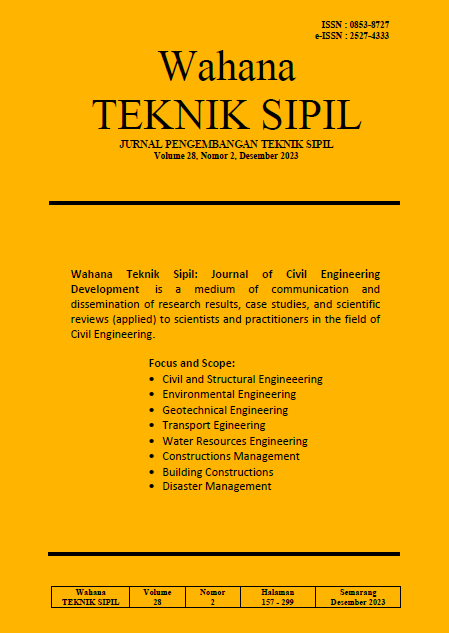PERBANDINGAN TINGKAT KEHALUSAN FLY ASH TERHADAP DURABILITAS DAN SIFAT MEKANIS HIGH VOLUME FINE FLY ASH-SELF COMPACTING CONCRETE
DOI:
https://doi.org/10.32497/wahanats.v28i2.5243Keywords:
Durability, mechanical properties, fine fly ash, self compacting concreteAbstract
Construction made from concrete, both conventional concrete and Self Compacting Concrete (SCC), which contact with seawater, often run into decreased durability due to the content of chemical compounds that are harmful for concrete, such as Magnesium Sulfate (MgSO4) and Chloride (Cl). One way to overcome this problem is to use fine fly ash in the concrete mixture. This article discusses the results of an experimental study on the use of fine fly ash in High Volume Fly Ash- Self Compacting Concrete on durability and mechanical properties. Fine fly ash used is processed using the fly ash filtering method with a water filter. The research method is a laboratory experiment by making concrete test objects. Durability tests include Volume of Permeable Voids (VPV) and Rapid Chloride Penetration Test (RCPT), while mechanical properties is concrete compressive strength. The research results showed that using fine fly ash compared to concrete without fly ash or concrete with raw fly ash positively impacted increasing compressive strength, reducing concrete voids, and good resistance to chloride attack at low penetration levels.
References
ACI Committe 211, 2006, Standard Practice for Selecting Proportions for Normal, Heavyweight, and Mass Concrete (ACI 211.1-91). 9, 120”“121.
ASTM C 642-06, 1997, Standard Test Method for Density, Absorption, and Voids in Hardened Concrete, ASTM International, United States. In American Society for Testing and Materials. (Issue March).
ASTM C1202, 2012, Standard Test Method for Electrical Indication of Concrete”™s Ability to Resist Chloride Ion Penetration.
Atiqurrohman, M., Utami, N.M., & Nurtanto, D., 2023, Korelasi Kuat Tekan Beton Dan Ketahanan Sulfat Pada Beton Normal Dengan Penambahan Kaolin Sebagai Subtitusi Parsial Semen. Teras Jurnal, 13 (1).
Cement Concrete & Aggregates, 2009, Chloride Resistance of Concrete. In Cement Concrete & Aggregates Australia (Issue June).
Chindaprasirt, P., Kroehong, W., Damrongwiriyanupap, N., Suriyo, W., & Jaturapitakkul, C., 2020, Mechanical properties, chloride resistance and microstructure of Portland fly ash cement concrete containing high volume bagasse ash. Journal of Building Engineering, 31 (April), 101415.
EFNARC, 2002, Specification and Guidelines for Self-Compacting Concrete. Report from EFNARC, 44 (February), 32.
Feng, T., Jiang, J., Chu, H., Wang, L., Science, M., & Engineering, C., 2020, Effect of Ultra-Fine Fly Ash on The Mechanical and Shrinkage Properties of Ultra-High Performance. 4th International RILEM Conference on Microstructure Related Durability of Cementitious Composites, 1, 534”“540.
Garg, R., Garg, R., Eddy, N.O., Khan, M.A., Khan, A.H., Alomayri, T., & Berwal, P., 2023, Mechanical strength and durability analysis of mortars prepared with fly ash and nano-metakaolin. Case Studies in Construction Materials, 18 (November 2022), e01796.
Gunasekara, C., Zhou, Z., Law, D.W., Sofi, M., Setunge, S., & Mendis, P., 2020, Microstructure and strength development of quaternary blend high-volume fly ash concrete. Journal of Materials Science, 55 (15), 6441”“6456.
Herath, C., Gunasekara, C., Law, D.W., & Setunge, S., 2020, Performance of high volume fly ash concrete incorporating additives: A systematic literature review. Construction and Building Materials, 258, 120606.
Kara De Maeijer, P., Craeye, B., Snellings, R., Kazemi-Kamyab, H., Loots, M., Janssens, K., & Nuyts, G., 2020, Effect of ultra-fine fly ash on concrete performance and durability. Construction and Building Materials, 263, 120493.
Moghaddam, F., Sirivivatnanon, V., & Vessalas, K., 2019, The effect of fly ash fineness on heat of hydration, microstructure, flow and compressive strength of blended cement pastes. Case Studies in Construction Materials, 10 (2018), e00218.
Nawaz, M.A., Ali, B., Qureshi, L.A., Usman Aslam, H.M., Hussain, I., Masood, B., & Raza, S.S., 2020, Effect of sulfate activator on mechanical and durability properties of concrete incorporating low calcium fly ash. Case Studies in Construction Materials, 13.
Paul, S.C., van Zijl, G.P.A.G., & Å avija, B., 2020, Effect of fibers on durability of concrete: A practical review. Materials, 13 (20), 1”“26.
Pratiwi, W.D., Triwulan, Ekaputri, J.J., & Fansuri, H., 2020, Combination of precipitated-calcium carbonate substitution and dilute-alkali fly ash treatment in a very high-volume fly ash cement paste. Construction and Building Materials, 234, 117273.
Rashad, A.M., 2015, An exploratory study on high-volume fly ash concrete incorporating silica fume subjected to thermal loads. Journal of Cleaner Production, 87, 735”“744.
Saha, A.K., 2018, Effect of class F fly ash on the durability properties of concrete. Sustainable Environment Research, 28 (1), 25”“31.
Sevim, Ö., & Demir, Ä°., 2019, Physical and permeability properties of cementitious mortars having fly ash with optimized particle size distribution. Cement and Concrete Composites, 96, 266”“273.
Shaikh, F.U.A., & Supit, S.W.M., 2015, Compressive strength and durability properties of high volume fly ash (HVFA) concretes containing ultrafine fly ash (UFFA). Construction and Building Materials, 82, 192”“205.
Siddique, R., 2011, Properties of Self-Compacting Concrete Containing Class F Fly Ash. Materials and Design, 32 (3), 1501”“1507.
SNI 03-6827, 2002, Metode Pengujian Waktu Ikat Awal Semen Portland dengan Menggunakan Alat Vicat untuk Pekerjaan Sipil. In Badan Standardisasi Nasional.
SNI 2460-2014, 2014, Spesifikasi Abu Terbang Batubara dan Pozolan Alam Mentah atau yang Telah Dikalsinasi untuk Digunakan dalam Beton. Badan Standardisasi Nasional Indonesia, 16.
SNI 2493:2011, 2011, Tata cara pembuatan dan perawatan benda uji beton di laboratorium. Badan Standarisasi Nasional.
Solikin, Mochamad, & Setiawan, B., 2014, Mechanical properties of class C high volume fly ash concrete with lime water as mixing water. Applied Mechanics and Materials, 660, 312”“316.
Solikin, Mochammad, Ihsan, I.N., Setiawan, B., & Nurchasanah, Y., 2021, Analisis Kehalusan Fly Ash Sebagai Bahan Substitusi Semen Ash Mutu Normal. CEEDRiMS, 157”“163.
Supit, S.W.M., Shaikh, F.U.A., & Sarker, P.K., 2014, Effect of ultrafine fly ash on mechanical properties of high volume fly ash mortar. Construction and Building Materials, 51, 278”“286.
Trisnoyuwono, D., 2015, Pengaruh Penambahan Fly Ash Terhadap Sifat Workability Dan Sifat Fisik - Mekanik Beton Non Pasir Dengan Agregat Alwa Asal Cilacap. Rekayasa Sipil, 9, pp.29-36.
Zhao, N., Wang, S., & Li, B., 2020, Durability of fibre concrete containing high-volume fly ash in complicated environment. Emerging Materials Research, 9 (3), 825”“830.
Downloads
Published
Issue
Section
License
Authors who publish with this journal agree to the following terms:Authors retain copyright and grant the journal right of first publication with the work simultaneously licensed under a Creative Commons Attribution License that allows others to share the work with an acknowledgement of the work's authorship and initial publication in this journal.
Authors are able to enter into separate, additional contractual arrangements for the non-exclusive distribution of the journal's published version of the work (e.g., post it to an institutional repository or publish it in a book), with an acknowledgement of its initial publication in this journal.
Authors are permitted and encouraged to post their work online (e.g., in institutional repositories or on their website) prior to and during the submission process, as it can lead to productive exchanges, as well as earlier and greater citation of published work (See The Effect of Open Access).






